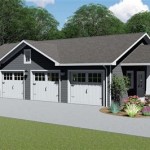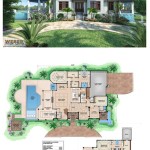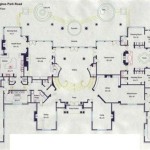Drawing a Floor Plan for Free: Tools and Techniques
Creating a floor plan is a fundamental step in any architectural, interior design, or real estate project. Whether planning a home renovation, designing a new building, or simply visualizing a space, an accurate and well-made floor plan provides a crucial visual representation. Traditionally, floor plans involved manual drafting with pencils, rulers, and specialized tools. However, the advent of digital technology has revolutionized the process, making it easier and more accessible than ever before. Numerous software and online tools now allow individuals to draw floor plans for free, offering features that streamline the design process and facilitate collaboration.
The availability of free floor plan software has democratized architectural design, allowing homeowners, renters, and small business owners to experiment with spatial arrangements without needing to hire professional architects for initial planning. These accessible tools enable users to understand their space better, explore different layouts, and communicate their ideas effectively to contractors or designers. While professional CAD (Computer-Aided Design) software offers advanced features and precision, free alternatives provide a sufficient level of functionality for basic planning and visualization.
Key Point 1: Advantages of Using Free Floor Plan Software
Employing free floor plan software presents several significant advantages for various users. One of the primary benefits is cost savings. By utilizing free software, individuals can avoid the expenses associated with purchasing professional-grade CAD programs or hiring an architect for initial concept designs. This affordability makes it possible for a broader range of people to engage in design projects, from homeowners planning minor renovations to small businesses designing their office spaces.
Another advantage is the ease of use offered by many free floor plan tools. These programs are often designed with user-friendly interfaces and intuitive controls, making them accessible to individuals with little to no prior experience in architectural design. Many platforms offer drag-and-drop functionality, pre-designed templates, and extensive libraries of furniture and fixture symbols, simplifying the process of creating a floor plan. This usability allows users to quickly learn the basics and begin designing their spaces effectively.
Collaboration is another significant benefit. Many free floor plan tools are web-based or offer cloud storage, enabling multiple users to access and edit the same floor plan concurrently. This feature facilitates collaboration among family members, colleagues, or even contractors, ensuring that everyone is on the same page regarding the design. Real-time updates and commenting features further enhance communication and streamline the design process.
Free floor plan software also allows for rapid prototyping and experimentation. Users can easily test different layouts, furniture arrangements, and design concepts without incurring significant costs or time commitment. This flexibility encourages creativity and innovation, allowing individuals to explore various possibilities and refine their designs before committing to a final plan. The ability to visualize different options in 2D or 3D further enhances the design process, providing a realistic representation of the space.
Finally, many free floor plan tools offer export options, allowing users to save their designs in various formats, such as PDF, JPG, or DWG. These export options facilitate sharing the floor plan with contractors, architects, or other stakeholders, enabling them to understand the design and provide feedback. The compatibility with standard file formats ensures that the floor plan can be viewed and edited using different software, promoting seamless communication and collaboration across different platforms.
Key Point 2: Popular Free Floor Plan Tools
Numerous free floor plan tools are available online, each offering a unique set of features and capabilities. One of the most popular options is Floorplanner. This web-based tool allows users to create detailed 2D and 3D floor plans with an intuitive drag-and-drop interface. Floorplanner offers a vast library of furniture and fixture models, enabling users to furnish their spaces realistically. The platform also provides features for calculating room areas, adding dimensions, and exporting the floor plan in various formats.
Another widely used free floor plan tool is Planner 5D. This software offers a user-friendly interface and supports both 2D and 3D design. Planner 5D features a comprehensive catalog of furniture, decor items, and architectural elements, allowing users to create detailed and realistic floor plans. The platform also offers augmented reality (AR) features, enabling users to visualize their designs in real-world environments using their mobile devices.
Sweet Home 3D is a free, open-source floor plan application that can be downloaded and installed on Windows, macOS, and Linux. This software offers a wide range of features for creating detailed 2D and 3D floor plans. Sweet Home 3D allows users to import existing floor plans as background images and trace over them to create accurate designs. The software also supports the import of 3D models from various online sources, enabling users to customize their spaces with unique furniture and decor items.
SketchUp Free is a web-based version of the popular 3D modeling software SketchUp. While not specifically designed for floor plans, SketchUp Free can be used to create detailed 2D and 3D models of buildings and spaces. The software offers a wide range of tools for drawing, editing, and manipulating 3D objects, allowing users to create complex and realistic designs. SketchUp Free also has a vast online library of 3D models, providing users with access to a wide range of furniture, fixtures, and architectural elements.
RoomSketcher is another web-based floor plan tool that offers both free and paid versions. The free version allows users to create basic 2D floor plans with a limited selection of furniture and fixture models. RoomSketcher also offers features for generating 3D visualizations and virtual tours of the floor plan. The paid versions offer additional features, such as the ability to create professional-quality 2D and 3D floor plans, generate high-resolution images, and collaborate with other users.
Key Point 3: Essential Elements of an Effective Floor Plan
Regardless of the tool used, certain essential elements contribute to the effectiveness of a floor plan. Accuracy is paramount. The floor plan should accurately represent the dimensions and layout of the space, including the placement of walls, doors, windows, and other architectural features. Inaccurate measurements can lead to errors during construction or renovation, resulting in costly mistakes and delays. Using precise measuring tools and paying attention to detail are crucial for ensuring accuracy.
Clarity is another essential element. The floor plan should be easy to understand and interpret, even by individuals who are not familiar with architectural design. Using clear and consistent symbols for doors, windows, furniture, and fixtures is important for conveying information effectively. Labeling rooms and spaces clearly also helps to ensure that the floor plan is easily understood.
Scalability is also an important consideration. The floor plan should be drawn to a specific scale, such as 1:50 or 1:100, to accurately represent the relative sizes of different elements. Including a scale bar on the floor plan allows users to easily measure distances and determine the dimensions of different features. Maintaining consistency in the scale throughout the floor plan is crucial for ensuring accuracy and proportionality.
Functionality should be a key consideration in the design of a floor plan. The layout of the space should be designed to optimize functionality and flow, ensuring that different areas are easily accessible and that the space is used efficiently. Considering the intended use of each room and the relationship between different spaces is important for creating a functional and livable floor plan.
Aesthetic appeal is also an important factor, although it is often secondary to functionality. The floor plan should be visually appealing and reflect the desired aesthetic style of the space. Considering the placement of furniture, decor items, and architectural features can help to create a visually pleasing and harmonious environment. Using different textures, colors, and patterns can also enhance the aesthetic appeal of the floor plan.
Finally, incorporating details such as electrical outlets, lighting fixtures, and plumbing lines can enhance the practicality and usefulness of the floor plan. Including these details can help to ensure that the design is feasible and that all necessary utilities are accounted for. Consulting with electricians and plumbers during the design process can help to identify potential issues and ensure that the floor plan meets all relevant building codes and regulations.

Draw Floor Plans Try Smartdraw Free And Easily More

Floor Plan Creator And Designer Free Easy App

Floor Plan Designer

Draw Floor Plans In Half The Time Cedreo

2d Floor Plans

Free Floor Plan Designer

Floor Plan Creator Planner 5d

20 Best Floor Plan To Create Your Plans Foyr

Floor Plan Creator Planner 5d

Floor Plan Maker








